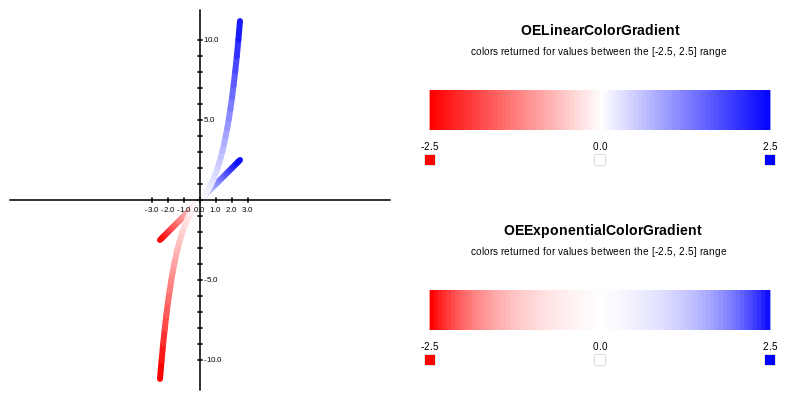OEExponentialColorGradient
class OEExponentialColorGradient : public OEColorGradientBase
The OEExponentialColorGradient class interpolates between colors that
are defined by using the OEColorStop class.
The OEExponentialColorGradient.TransformValue method
defines the transformation that is performed before returning an
interpolated color associated with a floating point value.
The Figure: Example of linear and exponential color gradients
illustrates the difference between a linear and a logarithmic colors
gradients constructed with the same color stops.

Example of linear and exponential color gradients generated with (-2.5, OERed), (0.0, OEWhite) and (+2.5, OEBlue) color stops
See also
OEColorStop class
OEExponentColorGradient class
OELinearColorGradient class
The following methods are publicly inherited from OEColorGradientBase:
Constructors
OEExponentialColorGradient()
Default constructor that creates an “empty” color gradient.
Note
An “empty” color gradient always returns the OEBlack
color, when calling the OEColorGradientBase.GetColorAt,
the OEColorGradientBase.GetMinColor or
the OEColorGradientBase.GetMaxColor methods.
OEExponentialColorGradient(const OEColorStop &oneStop)
Creates an OEExponentialColorGradient object with
one color stop. An OEExponentialColorGradient
object that has only one color stop will always return that
color when calling the
OEColorGradientBase.GetColorAt method.
OEExponentialColorGradient(const OEColorStop &bgnStop,
const OEColorStop &endStop)
Creates an OEExponentialColorGradient object with interpolation range between the two specified color stops.
OEExponentialColorGradient(const OEExponentialColorGradient &rhs)
Copy constructor.
operator=
OEExponentialColorGradient &operator=(const OEExponentialColorGradient &rhs)
Assignment operator.
TransformValue
double TransformValue(double value) const
Performs a
\(f(x) = -exp(-x)+1.0\) transformation when x is less than 0.0 and
\(f(x) = exp(x)-1.0)\) transformation when x is greater than 0.0.
This method is called by OEColorGradientBase.GetColorAt